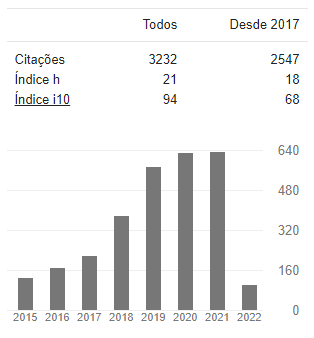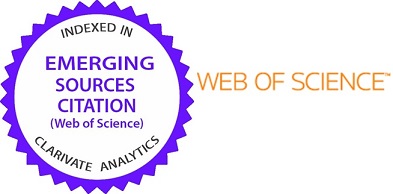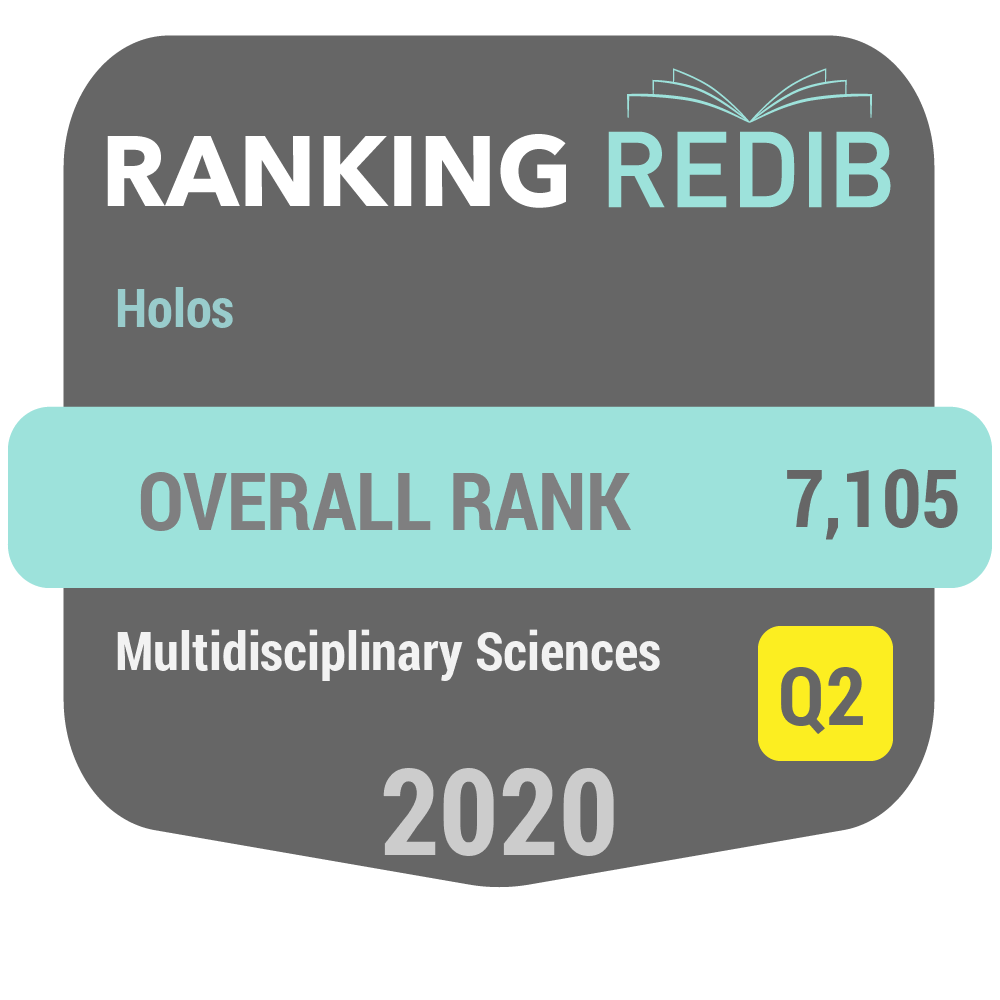Atributos antecessores à satisfação e à confiança no serviço de Internet Banking
DOI:
https://doi.org/10.15628/holos.2020.7116Palavras-chave:
Satisfação, Confiança, Internet BankingResumo
Este artigo identifica os atributos que são antecedentes à geração de confiança e satisfação para os usuários dos serviços internet banking. Trata-se de uma pesquisa do tipo survey que contou com a participação de 449 respondentes brasileiros. Os dados foram tratados utilizando procedimento estatístico de sistematização dos dados, análise fatorial exploratória, validade de construto, construção de escalas, análise fatorial confirmatória e modelagem de equações estruturais. O modelo teórico é formado por sete hipóteses sobre a relação entre confiança, satisfação, usabilidade, reputação e privacidade/segurança. No modelo proposto os construtos para confiança e satisfação aparecem como variáveis regressoras e apresentam um bom nível de confiabilidade permitindo que seja observada a sua importância na prestação de serviços de internet banking. Os resultados sinalizam que níveis mais elevados de usabilidade, reputação e privacidade/segurança proporcionados pelos usuários deste serviço contribuem para melhores graus de confiança e de satisfação. A forma com que as pessoas veem o serviço de internet banking, ao comparar os produtos e serviços oferecidos por outros sites de bancos concorrentes, se relacionam positivamente com a confiança e satisfação depositada na prestação do serviço. Os resultados mostram também que a confiança dos usuários na utilização do serviço de internet banking não é um antecessor do grau de satisfação do mesmo.Downloads
Referências
ARCAND, Manon et al. Mobile banking service quality and customer relationships. International Journal of Bank Marketing, v. 35, n. 7, p. 1068-1089, 2017.
BAILEY, J.; PEARSON, S. Development of a tool for measurement and analyzing computer user satisfaction. Management Science, 29(5), pp. 530 -575, 1983.
BAUER, H. H.; GRETHER, M.; LEACH, M. Building Customer Relations Over the Internet. Industrial Marketing Management, 31, pp. 155-163, 2002.
BART, Y.; SHANKAR, V.; SULTAN, F.; URBAN, G. L. Are the Drivers and Role of Online Trust the Same for All Web Sites and Consumers? A Large-Scale Exploratory Empirical Study. Journal of Marketing, 69, pp. 133-152, oct. 2005.
BERRY, L. Relationship marketing of services – perspectives from 1983 and 2000. Journal of Relationship Marketing, 1 (1), pp. 59-77, 2002.
BREI, V. A.; ROSSI, C. A. V. Confiança, Valor Percebido e Lealdade em Trocas Relacionadas de Serviço: Um Estudo com Usuários de Internet Banking no Brasil. RAC, 9 (2), pp. 145-168, 2005.
BUTT, M. M.; AFTAB, M. Incorporating attitude towards Halal banking in an integrated service quality, satisfaction, trust and loyalty model in online Islamic banking context. International Journal of Bank Marketing, 31(1), pp. 6-23, 2013.
CASALÓ, L.; CARLOS, F.; GUINALÍU, M. The Generation of Trust in the Online Services and Product Distribution: The case of Spanish Electronic Commerce. Journal of Electronic Commerce Research, 12 (3), pp. 199-213, 2011.
CORRITORE, C., KRACHER, B; WIEDENBECK, S. On-Line Trust: Concepts, Evolving Themes, a Model. International Journal of Human-Computer Studies, 58 (6), pp. 737-758, 2003.
ENNEW, C.; SEKHON, H. Measuring trust in financial services: the Trust Index. Conxumer Policy Review, 17 (2), mar./apr. 2007.
FÁVERO, L. P.; BELFIORE, P.; SILVA, F. L.; CHAN, B. L. Análise de dados: modelagem multivariada para tomada de decisões. 1 ed. Rio de Janeiro: Elsevier, 646p, 2009.
FEBRABAN, “Pesquisa FEBRABAN de Tecnologia Bancária 2019”, 2019. Disponível em: < https://portal.febraban.org.br/pagina/3106/48/pt-br/pesquisa > Acesso em 27/08/2019.
FLAVIÁN. C.; M. GUINALÍU. Consumer Trust, Perceived Security, and Privacy Policy: Three Basic Elements of Loyalty to a Website. Industrial Management and Data Systems, 106 (5), pp. 601-620, 2006.
GEORGE, A.; KUMAR, G. S. G. Validation of a scale for measuring problems in internet banking and their effect on customer satisfaction. Vision: The Journal of Business Perspective. Vol. 19, nº 4, pp. 312-323, dec. 2015.
GERRARD, P.; CUNNINGHAM, J. B.; DEVLIN, J. F. Why consumers are not using internet banking: a qualitative study. Journal of Services Marketing, 20 (3), pp. 160–168, 2006.
GIOVANNINI, C. J.; NUNES, D. C. G.; FERREIRA, D. B. Satisfação e Confiança do Consumidor em Ambientes Virtuais de Corretoras de Valores. Anais do XXXVI Encontro da ANPAD, Rio de Janeiro, 2012.
GRÖNROOS, C. Service management and marketing: a customer relationship management approach. 2 ed. England: Wiley, p. 394, 2000.
GUPTA, K. K.; BANSAL, I. Development of an Instrument to Measure Internet Banking Service Quality in India. Journal os Arts, Science & Commerce, 3 (2), apr. 2012.
GUTMAN, L. F. D.; JOIA, L. A.; MORENO JR., V. A. Antecedentes da intenção de uso de sistemas de home broker sob a ótica dos investidores do mercado acionário. Revista de Administração, 49 (2), pp. 353–368, 2014.
HAIR, J. F.; TATHAM, R. L.; ANDERSON, R. E.; BLACK, W. Análise multivariada de dados. 6.ed. Porto Alegre: Bookman, 688p, 2009.
HANSON, W. Principles of internet marketing. Cincinnati: South-Western College Publishing, 2000.
HERNANDEZ, J. M. D. C.; MAZZON, J. A. Um estudo empírico dos determinantes da adoção de Internet Banking entre não usuários brasileiros. Revista de Administração Contemporânea, 12, p. 9–39, 2008.
IBRAHIM, E. N. M.; NOOR, N. L. M; MEHAD, S. Trust or distrust in the web-mediated information environment (W-MIE): A perspective of online Muslim users. Journal os Enterprise Information Management, 22(5), pp. 523-547, 2009.
IVES, B., OLSON, M.; BAROUDI, S. The measurement of user information satisfaction. Communications of the ACM, 26(10), pp. 785–793, 1983.
JARVENPAA, S. L.; TRACTINSKY, N.; VITALE, M. Consumer trust in an internet store. Information Technology and Management, 1 (1), pp. 45-71, 2000.
JOSANG, A.; ISMAIL, R.; BOYD, C. A Survey of Trust and Reputation Systems for Online Service Provision. Decision Support Systems, 43 (2), pp. 618–644, 2007.
KANTOWITZ, B. H.; HANKOWSKI, R. J.; KANTOWITZ, S. C. Driver Acceptance of Unreliable Traffic Information in Familiar and Unfamiliar Settings. Human Factors, 39 (2), pp. 164–176, 1997.
KESHARWANI, A.; BISHT, S. S. The impact of trust and perceived risk on internet banking adoption in India: An extension of technology acceptance model. International Journal of Bank Marketing, 30 (4), pp. 303–322, 2012.
KHAN, Imran; RAHMAN, Zillur. Brand experience and emotional attachment in services: The moderating role of gender. Service Science, v. 9, n. 1, p. 50-61, 2017.
KLINE, P. The handbook of psychological testing. Routledge: London, 2000.
KLINE, R.B. Principles and practice of structural equation modeling. New York London: The Guilford Press. 2 ed, 366p, 2005.
KOLSAKER, A.; PAYNE, C. Engendering Trust in e-Commerce: A Study of Gender-based Concerns. Marketing Intelligence and Planning, 20 (4), pp. 206-214, 2002.
KOMIAK, S. X.; BENBASAT, I. Understanding Customer Trust in Agent-Mediated Electronic Commerce, Web-Mediated Eletronic Commerce, and Traditional Commerce. Information Technology and Management, 5 (1), pp. 181-207, jan. 2004.
LEE, N.; HOOLEY. G. The evolution of “classical mythology” within marketing measure development. European Journal of Marketing, 39 (3/4), pp. 365- 385, 2005.
LI, Y. Empirical studies on online information privacy concerns: literature review and an integrative framework. Communications of the Association for Information Systems, [S.l.], v. 28, n. 1, p. 453-496, 2011.
LIAO, Z.; CHEUNG, M. T. Measuring consumer satisfaction in internet banking: a core framework. Communications of the ACM, 51 (4), pp. 47-51, 2008.
LIAO, C.; LIU, C. C.; CHIEN, K. Examining the impact of privacy, trust and risk perceptions beyond monetary transactions: an integrated model. Electronic Commerce Research and Applications, [S.l.], v. 10, n. 6, p. 702-715, 2011.
LIÉBANA?CABANILLAS, F.; MUÑOZ?LEIVA, F.; REJÓN?GUARDIA, F. The determinants of satisfaction with e-banking. Industrial Management & Data Systems, 113(5), pp. 750-767, 2013
LOEBBECKE, C.; HORNIG, V. Increasing trust in e-commerce: concepts and examples of insurance solutions. In: 14TH Bled Electronic Commerce Conference. Bled, Slovenia. June. 2001.
MA, Z. Assessing Serviceability and Reliability to Affect Customer Satisfaction of Internet Banking. Journal of Software, 7 (7), 2012.
MARÔCO, J. Análise de Equações Estruturais: fundamentos teóricos, software & aplicações. 1ª ed. Lisboa – Portugal, ReportNumber, 2010.
MARÔCO, J. Análise Estatística com o SPSS Statistics. 5ª ed. Lisboa – Portugal, ReportNumber, 2011.
MELONE, N.P. A theoretical assessment of the user satisfaction construct in information systems research. Management Science, pp. 76-91, 1990.
MORGAN, R.; HUNT, S. The Commitment-Trust Theory of Relationship Marketing. Journal of Marketing, 58 (3), pp. 20-38, Jul. 1994. MORGAN-THOMAS, A.; VELOUTSOU, C. Beyond technology acceptance: Brand relationships and online brand experience. Journal of Business Research, 66 (1), pp. 21–27, 2013.
MOORMAN, C.; DESHPANDÉ, R.; ZALTMAN, G. Factors Affecting Trust in Market Research Relationships. Journal of Marketing, 57 (1), pp. 81-101, Jan. 1993.
MOUTINHO, L.; SMIT, A. Modelling bank customer satisfaction through mediation of attitudes towards human and automated banking. International Journal of Bank Marketing, 18 (3), pp. 124-134, 2000.
MUIR, B. M.; MORAY, N. Trust in automation: Part H Experimental studies of (rust and human intervention in a process control simulation. Ergonomics, 39 (3), pp. 429-461, 1996.
OFORI, Kwame Simpe et al. Examining customers’ continuance intentions towards internet banking usage. Marketing Intelligence & Planning, v. 35, n. 6, p. 756-773, 2017.
O´MALLEY, L.; TYNAN, C. Relationship marketing in consumer markets – rhetoric or reality? European Journal of Marketing, 34(7), pp. 797-815, 2000.
POLATOGLU, V. N.; EKIN, S. An empirical investigation of the Turkish consumers' acceptance of internet banking services. International Journal of Bank Marketing, 19 (4), pp. 156-165, 2001.
PRADO, E. P. V. Sites de Internet Banking: Uma Avaliação da Qualidade Baseada no Modelo Webqual. Gestão & Regionalidade. 26 (77), 2010.
RIQUELME, H. E.; MEKKAOUI, K. A.; RIOS, R. E. Internet Banking Customer Satisfaction and Online Service Attributes. Journal of Internet Banking and Commerce, 14 (2), 2009.
ROUSSEAU, D. M.; SITKIN, S. B.; BURT, R. S.; CAMERER, C. Not so Different After All: A Cross Discipline View of Trust. The Academy of Management Review, 23 (3), pp. 393-404, Jul. 1998.
ROOSTIKA, RATNA Perceived service quality and trust on satisfaction: customer’s perspectives in the banking sector. Jurnal Keuangan dan Perbankan, 15(2), pp. 271-280, 2011.
SAFEENA, R.; KAMMANI, A.; DATE, H. Assessment of Internet Banking Adoption: An Empirical Analysis. Arabian Journal for Science and Engineering, 39 (2), p. 837–849, 2014.
SANTOS, T. S.; CONDE, D. R.; SANTOS, T. S.; ANTONIALLI, L. M. Internet Banking: perfil do usuário e qualidade percebida pelos clientes bancários de Lavras/MG. Anais do III Encontro de Administração da Informação, Porto Alegre, 2011.
SEDDON, P. B. A Respecification and Extension of the DeLone and McLean Model of IS Success. Information Systems Research, 8 (3), pp. 240-253, 1997.
SELNES, F. Antecedents and Consequences of Trust and Satisfaction in Buyer-Seller Relationships. European Journal of Marketing, 32 (3), pp. 305-322, 1998.
SIKDAR, P.; KUMAR, A.; MAKKAD, M. Online Banking Adoption: A Factor Validation and Satisfaction Causation Study in the Context of Indian Banking Customers. International Journal of Bank Marketing, 33 (6), p. 760–785, 2015.
SUSANTO, A.; CHANG, Y.; HA, Y. Determinants of continuance intention to use the smartphone banking services: An extension to the expectation-confirmation model. Industrial Management & Data Systems, 116 (3), pp. 508-525, 2016.
TWUM, F.; AHENKORA, K. Internet Banking Security Strategy: Securing Customer Trust. Journal of Management and Strategy, 3 (4), pp. 78–83, 2012.
VIACAVA, J. J. C.; MANTOVANI, D.; KORELO, J. C.; PRADO, P. H. M. Vieses na satisfação: o efeito moderador da dificuldade e da obrigação sobre recordações positivas e negativas. Revista Eletrônica de Administração, 81 (2), pp. 437-461, 2015.
WIXOM, B. H.; TODD, P. A. A theoretical integration of user satisfaction and technology acceptance. Information Systems Research, 16(1), pp. 85-102, 2005.
YOUSAFZAI, S. Y.; FOXALL, G. R.; PALLISTER, J. G. Explaining internet banking behavior: theory of reasoned action, theory of planned behavior, or technology acceptance model? Journal of Applied Social Psychology, 40 (5), pp. 1172-1202, 2010.
YU, P. L.; BALAJI, M. S.; KHONG, K. W. Building trust in internet banking: a trustworthiness perspective. Industrial Management & Data Systems, 115 (2), pp. 235-252, 2015.
ZHAO, A. L.; LEWIS, N. K.; HANMER-LLOYD, S. & WARD, P. Adoption of internet banking services in China: is it all about trust? International Journal of Bank Marketing, 28 (1), pp. 7-26, 2010.
ZHU, Y.; CHEN, H. Service fairness and customer satisfaction in internet banking. Internet Research, 22 (4), pp. 482–498, 2012.





































